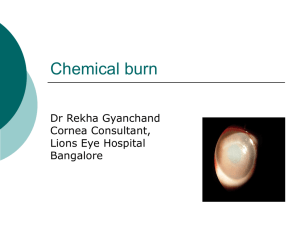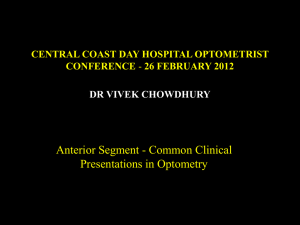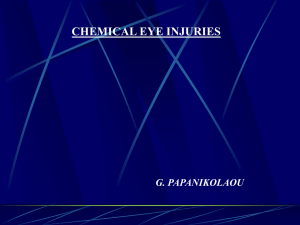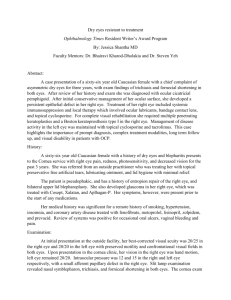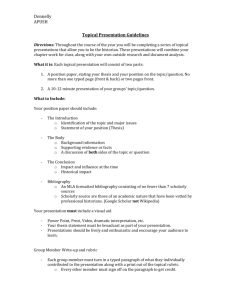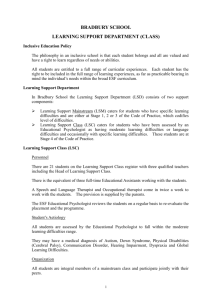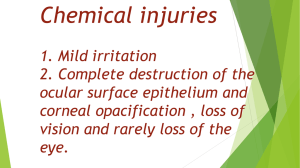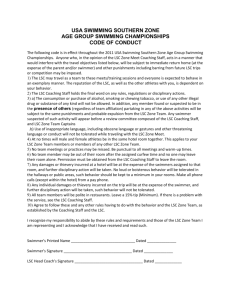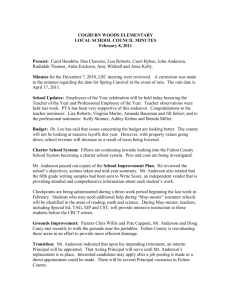Case Study: Patient complains of long standing blurred vision
advertisement
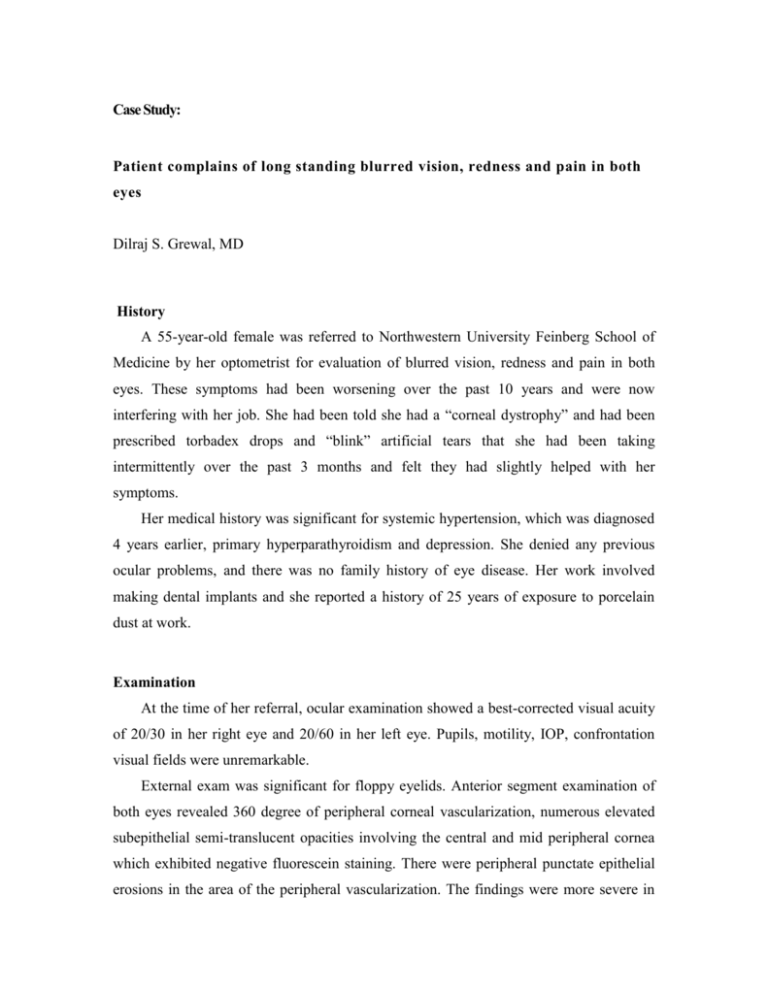
Case Study: Patient complains of long standing blurred vision, redness and pain in both eyes Dilraj S. Grewal, MD History A 55-year-old female was referred to Northwestern University Feinberg School of Medicine by her optometrist for evaluation of blurred vision, redness and pain in both eyes. These symptoms had been worsening over the past 10 years and were now interfering with her job. She had been told she had a “corneal dystrophy” and had been prescribed torbadex drops and “blink” artificial tears that she had been taking intermittently over the past 3 months and felt they had slightly helped with her symptoms. Her medical history was significant for systemic hypertension, which was diagnosed 4 years earlier, primary hyperparathyroidism and depression. She denied any previous ocular problems, and there was no family history of eye disease. Her work involved making dental implants and she reported a history of 25 years of exposure to porcelain dust at work. Examination At the time of her referral, ocular examination showed a best-corrected visual acuity of 20/30 in her right eye and 20/60 in her left eye. Pupils, motility, IOP, confrontation visual fields were unremarkable. External exam was significant for floppy eyelids. Anterior segment examination of both eyes revealed 360 degree of peripheral corneal vascularization, numerous elevated subepithelial semi-translucent opacities involving the central and mid peripheral cornea which exhibited negative fluorescein staining. There were peripheral punctate epithelial erosions in the area of the peripheral vascularization. The findings were more severe in her left eye (Figure 1). She had no evidence of facial or ocular rosacea but did have moderate blepharitis with posterior telangiectasia and meibomian gland dysfunction. Dilated fundus examination was unremarkable in both eyes. Discussion and diagnosis She was diagnosed with advanced limbal stem cell (LSC) disease and aqueous tear deficiency. Slit-lamp photographs demonstrated a demarcation line between healthy and unhealthy epithelium (Figure 1 left, arrow). She was started on a systematic regimen comprising of conservative measures and topical medical treatment. Conservative management included aggressive lubrication with preservative-free refresh optive artificial tears, lid hygiene and warm compresses. Medical management included prednisolone acetate ophthalmic suspension 1% (Pred Forte, Allergan, Irvine, CA) twice a day in both eyes and nightly topical vitamin A ointment (0.01%). A significant clinical response was noted with evidence of regressing conjunctival epithelial haze on review 1 month after the start of the steroid drops. At this time her steroid drops were discontinued and she was started on topical cyclosporine, 0.05% (Restasis; Allergan Inc, Irvine, California) in both eyes. Inferior punctal plugs (Oasis, Glenview, CA) were also placed in both eyes at this time. At 3 months follow-up, as a result of improvement in the ocular surface and corneal clarity, visual acuity improved in her left eye to 20/30. Cases with LSC deficiency occur most commonly in patients with aqueous tear film insufficiency in the setting of chronic traumatic or toxic insults to the limbus, in particular contact lens use or exposure to benzalkonium chloride, or as in our case longterm exposure to the micro-abrasive porcelain dust. In this setting of poor lubrication, the force of eyelid blinking could cause repeated micro-trauma to the limbus and cumulatively over time can lead to LSC disease. This is suggested by the presence of LSC disease in the superior quadrant of the limbus, which was also seen in our case. Therefore, in addition to stopping traumatic or toxic insults, optimizing the tear film with preservative-free lubricants and aggressive treatment of the lid margin disease is one of the primary interventions. Previous studies describing a whorl-like or advancing wave-like epitheliopathy have been shown in patients with similar a disease process. 1,2 An interesting clinical feature of these cases is the mixed phenotype of the cells growing onto the cornea. In particular in some of the early cases, before having a continuous sheet of late-staining epithelium, there appeared to be single clones of late-staining cells that follow a whorl-like path. In the setting of trauma or inflammation, the function of the LSCs or their niche may be disturbed, giving rise to goblet cells that migrate onto the cornea explaining the appearance of the late-staining epithelium on the cornea. Medical management is aimed primarily at restoring the limbal microenvironment. This involves a stepwise approach based on 2 fundamental strategies: (1) stopping traumatic or toxic insults to the limbus and (2) optimizing the ocular surface environment by improving the tear film, controlling inflammation, and promoting differentiation of healthy epithelium. The clinically significant response to steroids in this case of LSC disease suggests that chronic subclinical inflammation plays a significant role in the pathogenesis of such cases of LSC disease. Topical cyclosporine was used effectively as maintenance treatment after the inflammation had been controlled. It has been suggested that inflammation disturbs the normal milieu of the limbal niche and leads to dysfunction or aberrant differentiation of the LSCs, or both. 3-5 In a recent series of patients with LSC deficiency 5 Kim et al reported the outcomes of 22 eyes of 15 patients that were treated with medical therapy. The corneal epithelial phenotype returned to normal with only conservative measures, including lubrication and discontinuing contact lens wear in 4 patients (4 eyes), whereas in 11 patients (18 eyes), additional medical interventions were required after at least 3 months of conservative therapy. Medical interventions included topical corticosteroids, topical cyclosporine, topical vitamin A, oral doxycycline, punctal occlusion, or a combination thereof. All eyes achieved a stable ocular surface over a mean follow-up of 15 months and visual acuity improved from a mean of 20/42 to 20/26. If left untreated, chronic and persistent damage to the limbal niche may lead to permanent loss of the niche, and hence LSC deficiency, requiring surgical intervention including superficial keratectomy and amniotic membrane transplantation, LSC transplantation, or both. 2,6 The goal of surgical intervention is to restore the limbal microenvironment. As a first step, all toxic or traumatic stimuli should be discontinued, including contact lens use and all potentially toxic eye drops. At the same time, the tear film should be optimized using preservative-free artificial tears and aggressive treatment of associated lid disease. Patients who did not respond to a few months of conservative medical management should be treated with topical corticosteroids (preferably nonpreserved if available) and reassessed after a few weeks to determine the clinical response. Topical cyclosporine can be used to maintain ongoing anti-inflammatory activity as steroids are being tapered. After inflammation is controlled, punctal plugs or cautery may be considered in patients with more significant aqueous deficiency. Adjunctive measures such as topical vitamin A and autologous serum drops may be considered to improve the tear film and epithelial health and scleral lenses can be used for recalcitrant cases. Conclusion This case demonstrates many important points about the presentation, evaluation, and management of patients with LSC deficiency. Although this condition is rare, recognition by the ophthalmologist can be important for early identification and treatment. A stepwise approach involving conservative measures and medical management can result in good outcomes with significant improvement in visual acuity, resolution of symptoms while avoiding the need for surgical intervention. References 1. 2. 3. 4. 5. 6. Jeng BH, Halfpenny CP, Meisler DM, Stock EL. Management of focal limbal stem cell deficiency associated with soft contact lens wear. Cornea. Jan 2011;30(1):18-23. D'Aversa G, Luchs JL, Fox MJ, Rosenbaum PS, Udell IJ. Advancing wave-like epitheliopathy. Clinical features and treatment. Ophthalmology. Jun 1997;104(6):962-969. Pajoohesh-Ganji A, Pal-Ghosh S, Tadvalkar G, Stepp MA. Corneal goblet cells and their niche: implications for corneal stem cell deficiency. Stem cells. Sep 2012;30(9):2032-2043. Marsh P, Pflugfelder SC. Topical nonpreserved methylprednisolone therapy for keratoconjunctivitis sicca in Sjogren syndrome. Ophthalmology. Apr 1999;106(4):811-816. Kim BY, Riaz KM, Bakhtiari P, et al. Medically Reversible Limbal Stem Cell Disease: Clinical Features and Management Strategies. Ophthalmology. Jun 4 2014. Anderson DF, Ellies P, Pires RT, Tseng SC. Amniotic membrane transplantation for partial limbal stem cell deficiency. The British journal of ophthalmology. May 2001;85(5):567-575. Legends Figure 1: Slit-lamp photograph of our patient with superior limbal stem cell (LSC) disease demonstrating significant superior corneal vascularization, a demarcation line between healthy and unhealthy epithelium (arrow) and several sub-epithelial opacities which are easily seen on the retro-illumination picture (right).
